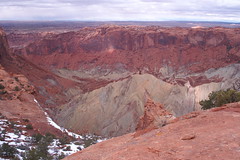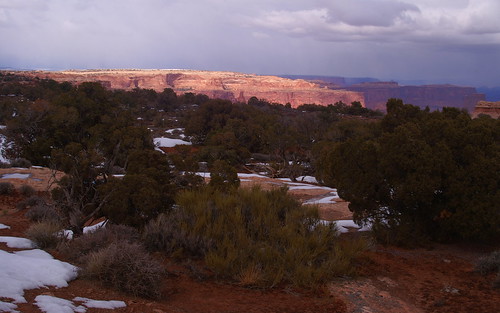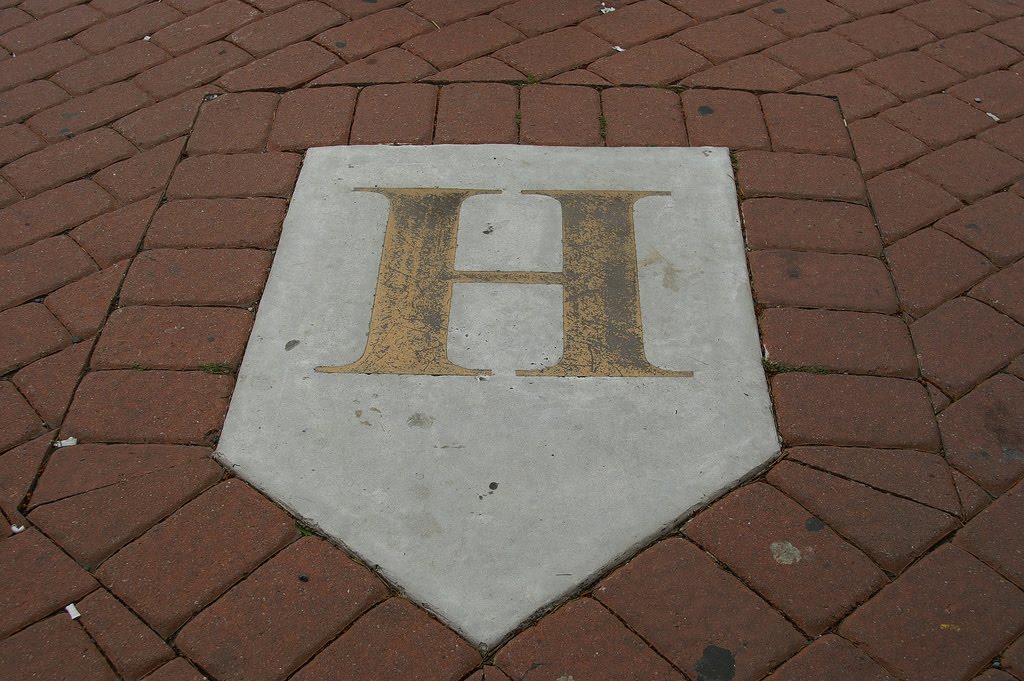After reading Desert Solitaire in college, I had my heart set on visiting Arches during my post-grad cross-country adventure, yet I somehow only allowed an afternoon for exploration, and that's clearly not enough. I also didn't take into account that Canyonlands National Park is less than an hour to the west of Arches' entrance. On this trip, I didn't overlook that proximity.
We got ourselves up only a little after the sun -- which wasn't showing through the cloud cover anyway -- and were on the road north through southern Utah and the snow. Monument Valley was dry, if overcast, with just a powdered-sugar dusting across the desert. At the top of the hill at the end of a long stretch of U.S. 163, I pulled over for a few photos, getting a bit of a different view from the one seen in Forrest Gump when he decides he's had enough of the running. In getting out of the car, I feel my foot hit the underside of the dashboard, but think nothing of it. When I get back in the car and close the door, the icon on the dash showing a door ajar remains lit, but with all four doors closed, I cannot determine the source and assume it's a glitch. About 14 miles up the road, when we pause to photograph the rock formation that gives Mexican Hat, Utah, its name, I happen to notice that the hood had been "popped" -- thank God for the latch that serves as a second form of closure. Why the Ford Fusion uses the door ajar light to indicate the hood has been disengaged is another matter.
The road continues to wind around the buttes and mesas, changing elevation and passing through the towns and settlements of Bluff, White Mesa, Blanding (where I believe I stayed back in '98), Monticello (where we doubled back for a picture of Shake Shack's southwestern cousin) and then Moab. We kept driving right out of town, across the Colorado River and past Arches' entrance to Utah 313, turning left and heading west to Canyonlands' Island in the Sky district. We saw few other cars on the road and just one was parked at the visitor center when we stopped to get my passport stamped and use the restrooms -- the first of many pit toilets in our two days in the two parks. As we left the parking lot to drive deeper into the park, the older British couple whose car we saw crossed the street for some photos of the view. We'd encounter them at Mesa Arch and Upheaval Dome, too, but in our roughly four hours in the park, we saw no more than 10 other vehicles. Our first stop, Mesa Arch, offered an easy half-mile loop to the window on a vast mesa below the cliff. Before we left the parking lot, a group of four returned to their car. On the trail, we passed a ranger and a couple heading back to the parking area, saw the British couple arriving at the arch as we were leaving and encountered a couple from the University of Iowa (they each wore sweatshirts declaring as much, and their car advertised it too) as we came around the hill back to the parking lot. None of our subsequent stops would be busier, though Upheaval Dome equalled it.
Our first stop, Mesa Arch, offered an easy half-mile loop to the window on a vast mesa below the cliff. Before we left the parking lot, a group of four returned to their car. On the trail, we passed a ranger and a couple heading back to the parking area, saw the British couple arriving at the arch as we were leaving and encountered a couple from the University of Iowa (they each wore sweatshirts declaring as much, and their car advertised it too) as we came around the hill back to the parking lot. None of our subsequent stops would be busier, though Upheaval Dome equalled it.
Though the view from Mesa Arch was breathtaking -- and photos can't convey the vastness, nor the sensation of walking up to the archway and seeing nothing on the other side, at least not less than several hundred feet down -- I didn't realize that we had yet to truly experience Canyonlands. We drove on to Whale Rock, a large, rounded sandstone bulge resembling a half-submerged whale (the above-the-waterline view) visible along the road. Marked as a short hike on the map, we were drawn to it. As we entered the trail from the parking lot, a father and son finished gathering their things and would soon follow us along the path.
Casey went ahead and followed the cairns up and over small humps and hills, through a gulley or two and around the juniper trees. Thinking of the formation as a whale, though the tail isn't visible, we were near the lower third, and as I looked to my left I noticed a cairn atop the great beast's humpback. This trail was taking us to the top of the whale.
Soon we were climbing the long, gradual sloping back of the beast, encountering eroded pools and small clumps of earth deep enough to support a juniper or a few bushes. Having climbed a hundred feet or so from our starting point, we followed the cairns to the left around a steeper bulge atop the rock but had to tread carefully over some loose gravel lest we slip as if on marbles and risk a long, painful slide down the rock to the trees at the bottom. Once around the bulge, we reached the "head" of Whale Rock. A line -- a crack in the rock, or a second formation pushed up against the first -- marked a deliniation between head and body, and the trail before us, as marked by the cairns, suddenly grew steeper. I started up on all fours -- my hiking boots gaining traction on the face of the rock as I went hand-over-hand, leaning forward for better balance. When I got about two-thirds of the way up, Casey paused and sat, unsure about going further. I sat, too, just above her and we looked back at the view before us. We could see our car far below in the parking lot, the road snaking back the way we came and disappearing behind another hill. All else was pockets of snow on red rocks and desert flora.
As we sat there, we began to hear the voices of the father and son we'd seen in the parking lot. They were coming over the higher and steeper hump that we'd walked around. I decided that I'd come this far and wanted to finish the journey, so while Casey said she'd wait for me, I turned and finished my crawl-climb up the rock, needing only a few steps before I felt comfortable enough to stand up. About to tell Casey it wasn't bad at all, I turned to find her right behind me. "When I saw you do it so easily, I couldn't wuss out," she said. "Plus, I didn't want those two to come by and see me sitting there." At the top of Whale Rock, we had a vast view. Most of what lie to the north and east was obscurred by nearby ridges, but views to the west, south and southeast were wide open. If we weren't talking and couldn't hear the father and son, who were pleasant when we chatted with them, the only sound in our ears was that of the wind. We were so far from any airport, out of the way of any flight plans, there were no man-made sounds to be heard. We were mere specs on the rugged landscape, miles from any road that didn't dead-end at a cliff or a National Park Service parking lot. A few days ago, I thought the Grand Canyon was silence, but that was only in the middle of the night. Instead, this is silence: Canyonlands, 2 p.m., on a Wednesday. It may not be like this on a June Saturday, but it is on this day and it's noticeable. I love it.
At the top of Whale Rock, we had a vast view. Most of what lie to the north and east was obscurred by nearby ridges, but views to the west, south and southeast were wide open. If we weren't talking and couldn't hear the father and son, who were pleasant when we chatted with them, the only sound in our ears was that of the wind. We were so far from any airport, out of the way of any flight plans, there were no man-made sounds to be heard. We were mere specs on the rugged landscape, miles from any road that didn't dead-end at a cliff or a National Park Service parking lot. A few days ago, I thought the Grand Canyon was silence, but that was only in the middle of the night. Instead, this is silence: Canyonlands, 2 p.m., on a Wednesday. It may not be like this on a June Saturday, but it is on this day and it's noticeable. I love it.
Father and son took a few pictures -- "Dad! Get one of me kicking in the air!" the boy exulted before performing a karate kick atop Whale Rock as his dad snapped away -- and then settled themselves into a depression to shield themselves from the wind and eat their lunch. Moments earlier, we'd discussed together just what Upheaval Dome could be and whether we were looking at it from our vantage point, or if it lay beyond the formations in front of us. I speculated that it sat behind the rocks that rose from just beyond the parking lot at the end of the road that we could see. Casey and I left them to their lunch and descended the whale and returned to our car.
As soon as we parked at the Upheaval Dome parking lot, it was clear that the formation itself indeed lay beyond the rocks in front of us. The trail led up (and we once again passed the British couple) and soon we were standing at the edge of the mysterious cone protruding from an impressive crater. The two main theories on how Upheaval Dome came to be, with the latter believed to be more likely than the former, are a meteor impact or a salt dome. We had the viewing area to ourselves and then made our way along the ridge for a few hundred feet to gain a different perspective. After a short while, we headed back to the car and encountered on the way six new faces, plus the father and son, who paused to tell us that next they'd be driving to the Aztec Butte trail. "It looks like it will be a similar hike to whale rock!" they told us. As we drove past it, we chose not to explore it for ourselves, and I wonder if they were disappointed not to see our car at the trailhead or encounter us once more along the trail.
We had the viewing area to ourselves and then made our way along the ridge for a few hundred feet to gain a different perspective. After a short while, we headed back to the car and encountered on the way six new faces, plus the father and son, who paused to tell us that next they'd be driving to the Aztec Butte trail. "It looks like it will be a similar hike to whale rock!" they told us. As we drove past it, we chose not to explore it for ourselves, and I wonder if they were disappointed not to see our car at the trailhead or encounter us once more along the trail.
Instead we continued along the park road, turning off for the Green River Overlook, speaking softly to each other so as not to disturb the experience for the lone photographer there before us. Yet he is driven out and we soon follow when a 4-Runner full of frat brothers arrives and they talk loudly of impossible feats of agility in descending into the canyon or leaping over a chasm that would surely end in the best possible way: failure.
We continue on to what amounts to land's end in Canyonlands: Grand View Point. Two cars -- one of them sporting a bumper sticker reading "THE DUDE ABIDES," of which Casey must take a picture -- are all we see in the parking lot, and the quartet that abides soon returns to their Subaru and departs. We have just enough time to enjoy the view for ourselves and are returning to our car by the time the five brahs are pulling up.
Grand View Point stood out for me the moment I looked at the park map online, because I recalled Abbey's chapter in Desert Solitaire: "The Dead Man at Grandview Point". I'll let him describe it, because I can't top it:
Looking out on this panorama of light, space, rock and silence I am inclined to congratulate the dead man on his choice of jumping-off place; he had good taste. He had good luck -- I envy him the manner of his going: to die alone, on rock under sun at the brink of the unknown, like a wolf, like a graet bird, seems to me very good fortune indeed. To die in the open, under the sky, far from the insolent interference of leech and priest, before this desert vastness opening like a window onto eternity -- that surely was an overwhelming stroke of rare good luck.
"Jumping-off place," to clarify, is a metaphor for the missing man's passage from life into death; he did not literally jump from the point onto the open mesa of the White Rim. Abbey's brother found him under a tree a mile or so from where he'd parked his car.
And for this day, this chapter of our trip, Grand View Point -- today's maps break it into two words, unlike Abbey -- serves as our jumping-off point, for from here we get back into the car to return to Moab, eager to check into our hotel and walk over to the Moab Brewery for dinner. We're there early, eating in an uncrowded dining room, and I keep an eye on the Notre Dame Big East Tournament game I can see in the bar. Once I see that Notre Dame has a lead, I can tell by the motion on the court when the Irish score or when Seton Hall has the ball. ND puts the game away just as we're putting dinner away.
To enjoy a few more of the house brews, we decamp to the bar, finding two seats on a corner. Soon, a middle-aged man to Casey's left starts chatting with us about Big East basketball and we discuss the conference and the similarities in our backgrounds -- like Casey, he's from Pennsylvania (though the Philly area) and he went to Boston College. He moved to Moab by way of San Francisco and seemed to be enjoying his simpler life. "You know, I've never texted, tweeted or Facebooked," he said, just as Casey and I were wrapping up all three on our phones. We chatted a little about New Jersey too, at which point the shaggy young man to his left and said, "Excuse me, did I hear some discussion about New Jersey over here?"
Casey confirmed his query. "I just moved out here today from Teaneck," he said. Our first night of two in Moab and his first of many, and we each come across someone who lived 15 minutes away back east. Even in the desert southwest, were you can drive for miles on a designated highway and not see another car, even another sign of human settlement, this world seemed just a little smaller.



No comments:
Post a Comment